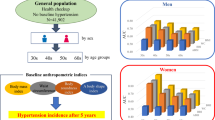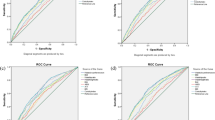Abstract
OBJECTIVE: To evaluate whether a single national reference is appropriate for assessing prevalence of overweight in heterogeneous populations, or whether ethnic-specific references are needed.
DESIGN: A population-based study of Israeli Jewish males who underwent routine physical and clinical examinations prior to army recruitment served as the basis for the development of two types of references for body mass index (BMI): a national reference (NR) and an ethnic-specific reference (ER).
SUBJECTS: Consecutive cohorts of all 17-y-old Jewish male recruits (n=109, 570).
MEASUREMENTS: Weight, height and blood pressure values were obtained. BMI was calculated, and the 85th percentile of BMI was used as a cut-off point for overweight, using both types of references. Prevalence of hypertension among recruits was used as a biomarker to support the reliability of the ER when discrepancy in classification between the two references was found.
RESULTS: As compared to the NR, three ethnic groups had a BMI distribution shifted to the left (light sub-population) and five were shifted to the right (heavy sub-population). In the light sub-population, 7% of the inductees who were classified as having normal weight by the NR were considered overweight by the ER and had a hypertension rate similar to that of those defined as overweight by both references (3.1 per 1000). In the heavy sub-population the 4% of subjects who were overweight by NR and normal by ER had hypertension rates similar to those defined as normal weight by both references (2.7/1000), and significantly lower than that of those classified as overweight by both references (10.8/1000).
CONCLUSION: In heterogeneous populations, ethnic references should be used to evaluate prevalence of overweight, rather than one national reference.
This is a preview of subscription content, access via your institution
Access options
Subscribe to this journal
Receive 12 print issues and online access
$259.00 per year
only $21.58 per issue
Buy this article
- Purchase on Springer Link
- Instant access to full article PDF
Prices may be subject to local taxes which are calculated during checkout

Similar content being viewed by others
References
Cronk CE, Roche AF . Race and sex-specific reference data for triceps and subscapular skinfolds and weight/stature Am J Clin Nutr 1982 35: 347–354.
Kemsley WFF . Body weight at different ages and heights Ann Eugenics 1952 18: 316–334.
Yanai M, Kon A, Kumasaka K, Kawano K . Body mass index variations by age and sex, and prevalence of overweight in Japanese adults Int J Obes Relat Metab Disord 1997 21: 484–488.
Sichieri R, Recine E, Everhart JE . Growth and body mass index of Brazilians ages 9 through 17 years Obes Res 1995 3 (Suppl 2): 117s–121s.
Lazarus R, Baur L, Webb K, Blyth F, Gliksman M . Recommended body mass index cutoff values for overweight screening programmes in Australian children and adolescents: Comparisons with North American values J Paediatr Child Health 1995 31: 143–147.
Wang J, Thornton JC, Burastero S, Shen J, Tanenbaum S, Heymsfield SB, Pierson RN, Jr . Comparisons for body mass index and body fat percent among Puerto Ricans, blacks, whites, and Asians living in the New York City area Obes Res 1996 4: 377–384.
Chinn S, Rona RJ, Gulliford MC, Hammond J . Weight-for-height in children aged 4–12 years. A new index compared to the normalized body mass index Eur J Clin Nutr 1992 46: 489–500.
Hammer LD, Kraemer HC, Wilson DM, Ritter PL, Dornbusch SM . Standardized percentile curves of body mass index for children and adolescents Am J Dis Child 1991 145: 259–263.
Solomon CG, Manson JE . Obesity and mortality: A review of the epidemiologic data Am J Clin Nutr 1997 66 (Suppl 4): 1044S–1050S.
Modan M, Lubin F, Lusky A, Chetrit A, Fuchs Z, Halkin H . Inter-relationship of obesity, habitual diet, physical activity and glucose intolerance in the four main Israeli Jewish ethnic groups. In Berry VEM, Blondheim SH, Eliahou HE, Shafrir E (eds) Recent advances in obesity research. John Libbey 1986 pp 46–53.
Lusky A, Barell V, Lubin F, Kaplan G, Layani V, Shohat Z, Lev B, Wiener M . Relationship between morbidity and extreme values of body mass index in adolescents Int J Epidemiol 1996 25: 829–834.
Gilbert TJ, Percy CA, White LL, Romero FC . Blood pressure and body measurements among Navajo adolescents Pub Health Rep 1996 111 (Suppl 2): 44–46.
Mikawa K, Ueshima H, Hashimoto T, Fujita Y, Naruse Y, Nakagawa H, Kasaneratsu T, Kagamimori S . An INTERSALT study investigation: Relationship between body mass index and blood pressure in the combined populations of three local centres in Japan J Hum Hypertens 1994 8: 101–105.
Khan TH, Mahmud Z, Zaidi SZ . Blood pressure and its correlates in the population of Multan, Pakistan Anthropol Anz 1996 54: 361–368.
Chen Y, Rennie DC, Reeder BA . Age-related association between body mass index and blood pressure: The Humboldt Study Int J Obes Relat Metab Disord 1995 19: 825–831.
Dustan HP . Obesity and hypertension Ann Intern Med 1985 103: 1047–1049.
Conover WJ . Practical nonparametric statistics, 2nd edn. John Wiley: New York 1971 pp 106–116,346.
McCullagh P, Nelder JA (eds) . Generalized linear models, 2nd edn. Chapman & Hall: London 1989.
Kark JD, Kedem R, Revach M . Medical examination of Israeli 17-year-olds before military service as a national resource for health information Isr J Med Sci 1986 22: 318–325.
Laor A, Seidman DS, Danon YL . Changes in body height among selected ethnic groups J Epidemiol Community Health 1991 45: 169–170.
Chen R, Wax Y, Lusky A, Toppelberg G, Barell V . A criterion for a standardized definition of low birthweight Int J Epidemiol 1991 20: 180–186.
Lazarus R, Baur L, Webb K, Blyth F . Body mass index in screening for adiposity in children and adolescents: Systematic evaluation using receiver operating characteristic curves Am J Clin Nutr 1996 63: 500–506.
Omura M, Zinno S, Harada T, Inoue N . Evaluation of validity of five weight-height obesity indices Fukuoka Igaku Zasshi 1993 84: 305–310.
Author information
Authors and Affiliations
Rights and permissions
About this article
Cite this article
Lusky, A., Lubin, F., Barell, V. et al. Body mass index in 17-year-old Israeli males of different ethnic backgrounds; national or ethnic-specific references?. Int J Obes 24, 88–92 (2000). https://doi.org/10.1038/sj.ijo.0801090
Received:
Revised:
Accepted:
Published:
Issue Date:
DOI: https://doi.org/10.1038/sj.ijo.0801090
Keywords
This article is cited by
-
Family Income and Low Birth Weight in Term Infants: a Nationwide Study in Israel
Maternal and Child Health Journal (2022)



